Tao Wu
RoLID-11K: A Dashcam Dataset for Small-Object Roadside Litter Detection
Jan 01, 2026Abstract:Roadside litter poses environmental, safety and economic challenges, yet current monitoring relies on labour-intensive surveys and public reporting, providing limited spatial coverage. Existing vision datasets for litter detection focus on street-level still images, aerial scenes or aquatic environments, and do not reflect the unique characteristics of dashcam footage, where litter appears extremely small, sparse and embedded in cluttered road-verge backgrounds. We introduce RoLID-11K, the first large-scale dataset for roadside litter detection from dashcams, comprising over 11k annotated images spanning diverse UK driving conditions and exhibiting pronounced long-tail and small-object distributions. We benchmark a broad spectrum of modern detectors, from accuracy-oriented transformer architectures to real-time YOLO models, and analyse their strengths and limitations on this challenging task. Our results show that while CO-DETR and related transformers achieve the best localisation accuracy, real-time models remain constrained by coarse feature hierarchies. RoLID-11K establishes a challenging benchmark for extreme small-object detection in dynamic driving scenes and aims to support the development of scalable, low-cost systems for roadside-litter monitoring. The dataset is available at https://github.com/xq141839/RoLID-11K.
Seeing the Whole Picture: Distribution-Guided Data-Free Distillation for Semantic Segmentation
Dec 15, 2025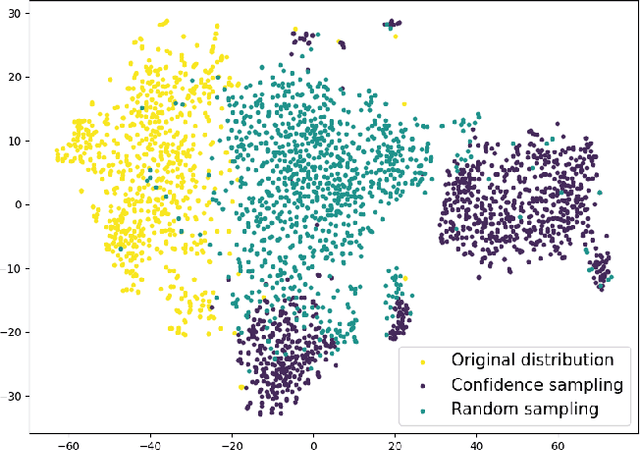
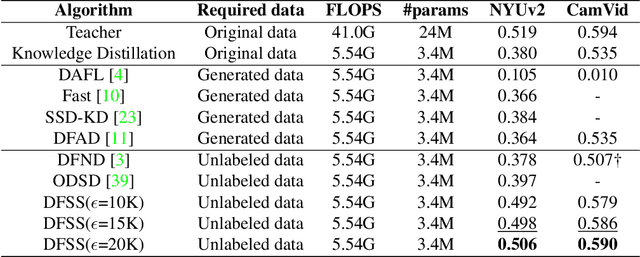
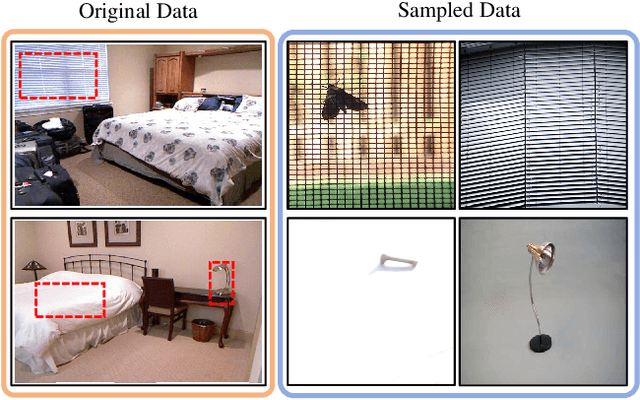
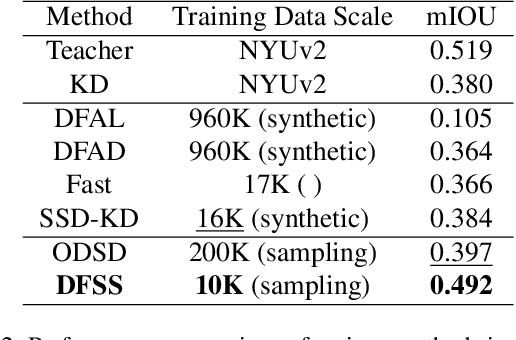
Abstract:Semantic segmentation requires a holistic understanding of the physical world, as it assigns semantic labels to spatially continuous and structurally coherent objects rather than to isolated pixels. However, existing data-free knowledge distillation (DFKD) methods-primarily designed for classification-often disregard this continuity, resulting in significant performance degradation when applied directly to segmentation tasks. In this paper, we introduce DFSS, a novel data-free distillation framework tailored for semantic segmentation. Unlike prior approaches that treat pixels independently, DFSS respects the structural and contextual continuity of real-world scenes. Our key insight is to leverage Batch Normalization (BN) statistics from a teacher model to guide Approximate Distribution Sampling (ADS), enabling the selection of data that better reflects the original training distribution-without relying on potentially misleading teacher predictions. Additionally, we propose Weighted Distribution Progressive Distillation (WDPD), which dynamically prioritizes reliable samples that are more closely aligned with the original data distribution early in training and gradually incorporates more challenging cases, mirroring the natural progression of learning in human perception. Extensive experiments on standard benchmarks demonstrate that DFSS consistently outperforms existing data-free distillation methods for semantic segmentation, achieving state-of-the-art results with significantly reduced reliance on auxiliary data.
GeoSceneGraph: Geometric Scene Graph Diffusion Model for Text-guided 3D Indoor Scene Synthesis
Nov 18, 2025Abstract:Methods that synthesize indoor 3D scenes from text prompts have wide-ranging applications in film production, interior design, video games, virtual reality, and synthetic data generation for training embodied agents. Existing approaches typically either train generative models from scratch or leverage vision-language models (VLMs). While VLMs achieve strong performance, particularly for complex or open-ended prompts, smaller task-specific models remain necessary for deployment on resource-constrained devices such as extended reality (XR) glasses or mobile phones. However, many generative approaches that train from scratch overlook the inherent graph structure of indoor scenes, which can limit scene coherence and realism. Conversely, methods that incorporate scene graphs either demand a user-provided semantic graph, which is generally inconvenient and restrictive, or rely on ground-truth relationship annotations, limiting their capacity to capture more varied object interactions. To address these challenges, we introduce GeoSceneGraph, a method that synthesizes 3D scenes from text prompts by leveraging the graph structure and geometric symmetries of 3D scenes, without relying on predefined relationship classes. Despite not using ground-truth relationships, GeoSceneGraph achieves performance comparable to methods that do. Our model is built on equivariant graph neural networks (EGNNs), but existing EGNN approaches are typically limited to low-dimensional conditioning and are not designed to handle complex modalities such as text. We propose a simple and effective strategy for conditioning EGNNs on text features, and we validate our design through ablation studies.
EchoDistill: Bidirectional Concept Distillation for One-Step Diffusion Personalization
Oct 23, 2025Abstract:Recent advances in accelerating text-to-image (T2I) diffusion models have enabled the synthesis of high-fidelity images even in a single step. However, personalizing these models to incorporate novel concepts remains a challenge due to the limited capacity of one-step models to capture new concept distributions effectively. We propose a bidirectional concept distillation framework, EchoDistill, to enable one-step diffusion personalization (1-SDP). Our approach involves an end-to-end training process where a multi-step diffusion model (teacher) and a one-step diffusion model (student) are trained simultaneously. The concept is first distilled from the teacher model to the student, and then echoed back from the student to the teacher. During the EchoDistill, we share the text encoder between the two models to ensure consistent semantic understanding. Following this, the student model is optimized with adversarial losses to align with the real image distribution and with alignment losses to maintain consistency with the teacher's output. Furthermore, we introduce the bidirectional echoing refinement strategy, wherein the student model leverages its faster generation capability to feedback to the teacher model. This bidirectional concept distillation mechanism not only enhances the student ability to personalize novel concepts but also improves the generative quality of the teacher model. Our experiments demonstrate that this collaborative framework significantly outperforms existing personalization methods over the 1-SDP setup, establishing a novel paradigm for rapid and effective personalization in T2I diffusion models.
GenColorBench: A Color Evaluation Benchmark for Text-to-Image Generation Models
Oct 23, 2025



Abstract:Recent years have seen impressive advances in text-to-image generation, with image generative or unified models producing high-quality images from text. Yet these models still struggle with fine-grained color controllability, often failing to accurately match colors specified in text prompts. While existing benchmarks evaluate compositional reasoning and prompt adherence, none systematically assess color precision. Color is fundamental to human visual perception and communication, critical for applications from art to design workflows requiring brand consistency. However, current benchmarks either neglect color or rely on coarse assessments, missing key capabilities such as interpreting RGB values or aligning with human expectations. To this end, we propose GenColorBench, the first comprehensive benchmark for text-to-image color generation, grounded in color systems like ISCC-NBS and CSS3/X11, including numerical colors which are absent elsewhere. With 44K color-focused prompts covering 400+ colors, it reveals models' true capabilities via perceptual and automated assessments. Evaluations of popular text-to-image models using GenColorBench show performance variations, highlighting which color conventions models understand best and identifying failure modes. Our GenColorBench assessments will guide improvements in precise color generation. The benchmark will be made public upon acceptance.
Every Step Evolves: Scaling Reinforcement Learning for Trillion-Scale Thinking Model
Oct 21, 2025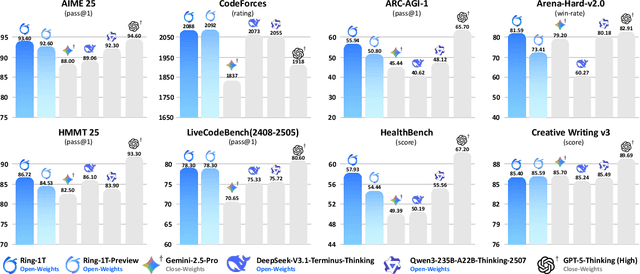
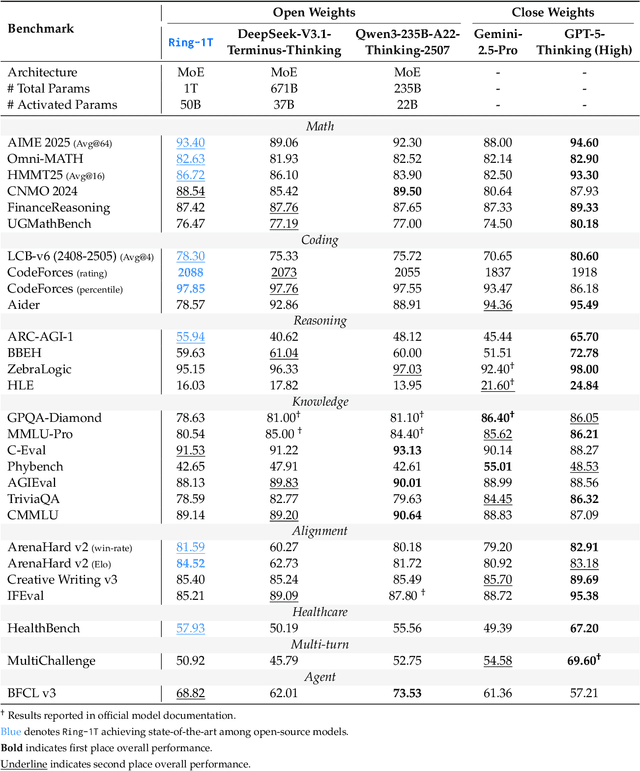
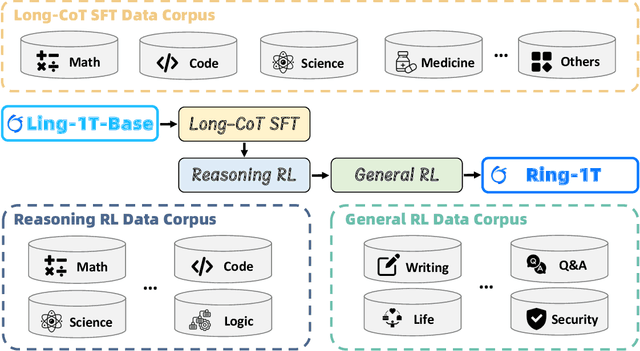
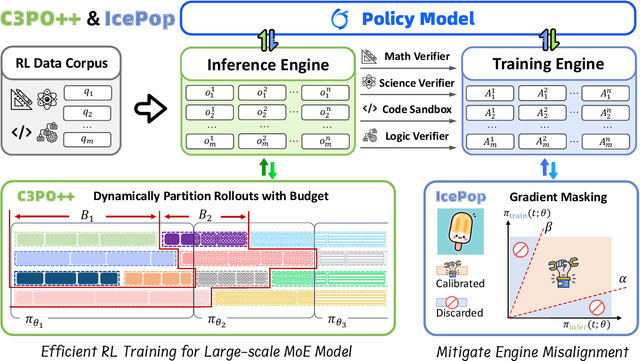
Abstract:We present Ring-1T, the first open-source, state-of-the-art thinking model with a trillion-scale parameter. It features 1 trillion total parameters and activates approximately 50 billion per token. Training such models at a trillion-parameter scale introduces unprecedented challenges, including train-inference misalignment, inefficiencies in rollout processing, and bottlenecks in the RL system. To address these, we pioneer three interconnected innovations: (1) IcePop stabilizes RL training via token-level discrepancy masking and clipping, resolving instability from training-inference mismatches; (2) C3PO++ improves resource utilization for long rollouts under a token budget by dynamically partitioning them, thereby obtaining high time efficiency; and (3) ASystem, a high-performance RL framework designed to overcome the systemic bottlenecks that impede trillion-parameter model training. Ring-1T delivers breakthrough results across critical benchmarks: 93.4 on AIME-2025, 86.72 on HMMT-2025, 2088 on CodeForces, and 55.94 on ARC-AGI-v1. Notably, it attains a silver medal-level result on the IMO-2025, underscoring its exceptional reasoning capabilities. By releasing the complete 1T parameter MoE model to the community, we provide the research community with direct access to cutting-edge reasoning capabilities. This contribution marks a significant milestone in democratizing large-scale reasoning intelligence and establishes a new baseline for open-source model performance.
MultiCrafter: High-Fidelity Multi-Subject Generation via Spatially Disentangled Attention and Identity-Aware Reinforcement Learning
Sep 26, 2025Abstract:Multi-subject image generation aims to synthesize user-provided subjects in a single image while preserving subject fidelity, ensuring prompt consistency, and aligning with human aesthetic preferences. However, existing methods, particularly those built on the In-Context-Learning paradigm, are limited by their reliance on simple reconstruction-based objectives, leading to both severe attribute leakage that compromises subject fidelity and failing to align with nuanced human preferences. To address this, we propose MultiCrafter, a framework that ensures high-fidelity, preference-aligned generation. First, we find that the root cause of attribute leakage is a significant entanglement of attention between different subjects during the generation process. Therefore, we introduce explicit positional supervision to explicitly separate attention regions for each subject, effectively mitigating attribute leakage. To enable the model to accurately plan the attention region of different subjects in diverse scenarios, we employ a Mixture-of-Experts architecture to enhance the model's capacity, allowing different experts to focus on different scenarios. Finally, we design a novel online reinforcement learning framework to align the model with human preferences, featuring a scoring mechanism to accurately assess multi-subject fidelity and a more stable training strategy tailored for the MoE architecture. Experiments validate that our framework significantly improves subject fidelity while aligning with human preferences better.
LADB: Latent Aligned Diffusion Bridges for Semi-Supervised Domain Translation
Sep 10, 2025Abstract:Diffusion models excel at generating high-quality outputs but face challenges in data-scarce domains, where exhaustive retraining or costly paired data are often required. To address these limitations, we propose Latent Aligned Diffusion Bridges (LADB), a semi-supervised framework for sample-to-sample translation that effectively bridges domain gaps using partially paired data. By aligning source and target distributions within a shared latent space, LADB seamlessly integrates pretrained source-domain diffusion models with a target-domain Latent Aligned Diffusion Model (LADM), trained on partially paired latent representations. This approach enables deterministic domain mapping without the need for full supervision. Compared to unpaired methods, which often lack controllability, and fully paired approaches that require large, domain-specific datasets, LADB strikes a balance between fidelity and diversity by leveraging a mixture of paired and unpaired latent-target couplings. Our experimental results demonstrate superior performance in depth-to-image translation under partial supervision. Furthermore, we extend LADB to handle multi-source translation (from depth maps and segmentation masks) and multi-target translation in a class-conditioned style transfer task, showcasing its versatility in handling diverse and heterogeneous use cases. Ultimately, we present LADB as a scalable and versatile solution for real-world domain translation, particularly in scenarios where data annotation is costly or incomplete.
Contrast-Free Ultrasound Microvascular Imaging via Radiality and Similarity Weighting
Sep 08, 2025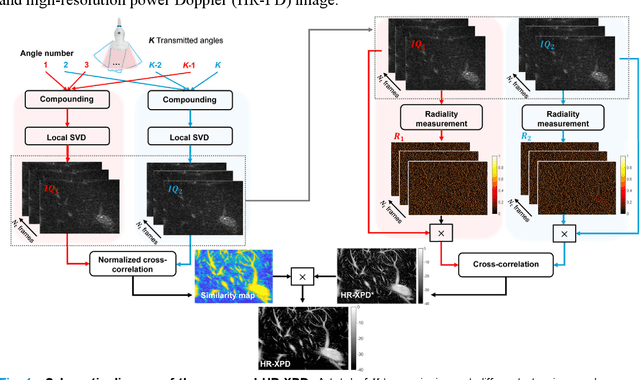
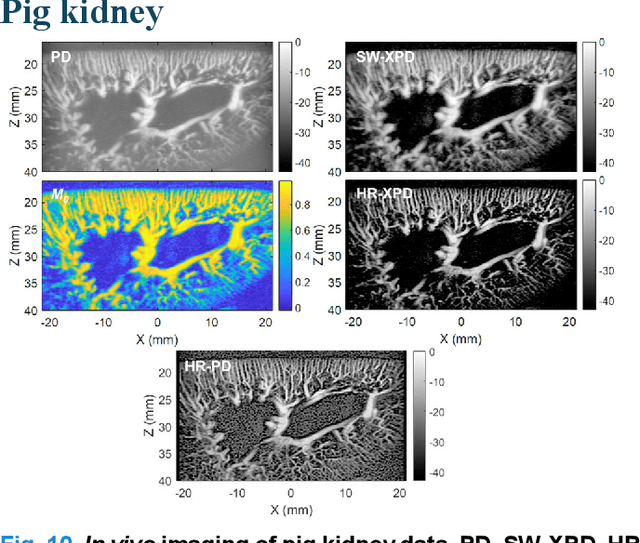
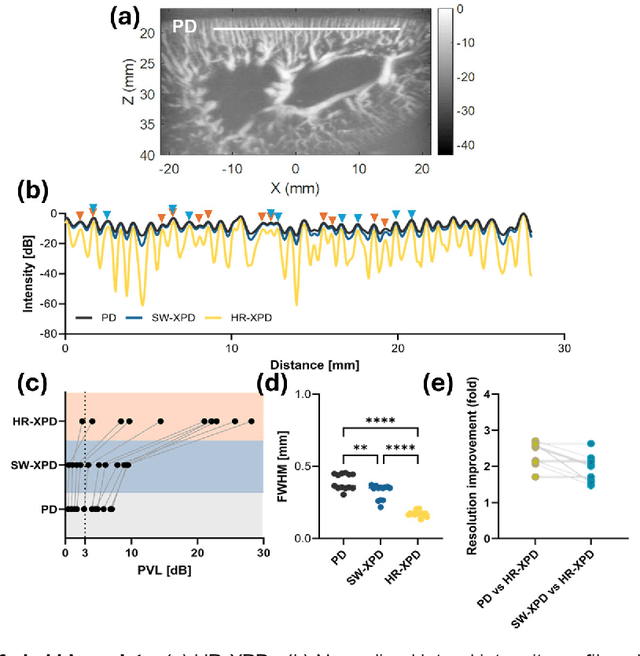
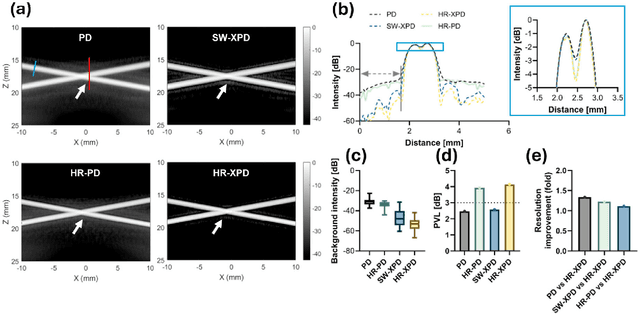
Abstract:Microvascular imaging has advanced significantly with ultrafast data acquisition and improved clutter filtering, enhancing the sensitivity of power Doppler imaging to small vessels. However, the image quality remains limited by spatial resolution and elevated background noise, both of which impede visualization and accurate quantification. To address these limitations, this study proposes a high-resolution cross-correlation Power Doppler (HR-XPD) method that integrates spatial radiality weighting with Doppler signal coherence analysis, thereby enhancing spatial resolution while suppressing artifacts and background noise. Quantitative evaluations in simulation and in vivo experiments on healthy human liver, transplanted human kidney, and pig kidney demonstrated that HR-XPD significantly improves microvascular resolvability and contrast compared to conventional PD. In vivo results showed up to a 2 to 3-fold enhancement in spatial resolution and an increase in contrast by up to 20 dB. High-resolution vascular details were clearly depicted within a short acquisition time of only 0.3 s-1.2 s without the use of contrast agents. These findings indicate that HR-XPD provides an effective, contrast-free, and high-resolution microvascular imaging approach with broad applicability in both preclinical and clinical research.
OneRec-V2 Technical Report
Aug 28, 2025



Abstract:Recent breakthroughs in generative AI have transformed recommender systems through end-to-end generation. OneRec reformulates recommendation as an autoregressive generation task, achieving high Model FLOPs Utilization. While OneRec-V1 has shown significant empirical success in real-world deployment, two critical challenges hinder its scalability and performance: (1) inefficient computational allocation where 97.66% of resources are consumed by sequence encoding rather than generation, and (2) limitations in reinforcement learning relying solely on reward models. To address these challenges, we propose OneRec-V2, featuring: (1) Lazy Decoder-Only Architecture: Eliminates encoder bottlenecks, reducing total computation by 94% and training resources by 90%, enabling successful scaling to 8B parameters. (2) Preference Alignment with Real-World User Interactions: Incorporates Duration-Aware Reward Shaping and Adaptive Ratio Clipping to better align with user preferences using real-world feedback. Extensive A/B tests on Kuaishou demonstrate OneRec-V2's effectiveness, improving App Stay Time by 0.467%/0.741% while balancing multi-objective recommendations. This work advances generative recommendation scalability and alignment with real-world feedback, representing a step forward in the development of end-to-end recommender systems.
 Add to Chrome
Add to Chrome Add to Firefox
Add to Firefox Add to Edge
Add to Edge